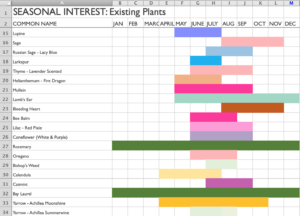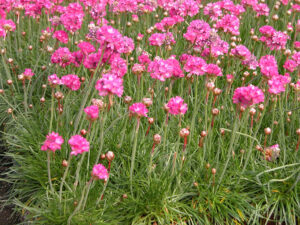 To capture the true beauty of plants, you ought to take note of the times in which they bloom. By documenting bloom times, in the form a seasonal bloom chart, you’re able to ensure a pop of color at all times of the year. In addition to blooms, you may want to capture the foliage change of leaves. These are the steps to creating your own seasonal bloom chart.
To capture the true beauty of plants, you ought to take note of the times in which they bloom. By documenting bloom times, in the form a seasonal bloom chart, you’re able to ensure a pop of color at all times of the year. In addition to blooms, you may want to capture the foliage change of leaves. These are the steps to creating your own seasonal bloom chart.
 Determine the plants you’re most interested in planting or, if you have a garden, the plants that already exist there. With either your plants of interest, or the plants you already have, do a quick search for each one, looking up the botanical name (if possible) along with “bloom time.”
Determine the plants you’re most interested in planting or, if you have a garden, the plants that already exist there. With either your plants of interest, or the plants you already have, do a quick search for each one, looking up the botanical name (if possible) along with “bloom time.”
Set up an Excel Workbook, Google Sheet, or Apple Numbers page with Plant names listed down the first column and each month of the year listed along the top. For each plant, choose a unique fill color that best represents it, and fill in the cells that correspond to its bloom time (i.e. September through December).
 Once you finish filling in the bloom times, you’ll be able to see when your desired plants or existing plants bloom the most. With that information, you may discover times of year that no desired or existing plants will bloom. If you’ve yet to plant, you may want to rethink a few plants and replace them with others that would bloom during those times without blooms. If the chart represents your current yard, similarly, you may want to add just a few plants that bloom when the others do not.
Once you finish filling in the bloom times, you’ll be able to see when your desired plants or existing plants bloom the most. With that information, you may discover times of year that no desired or existing plants will bloom. If you’ve yet to plant, you may want to rethink a few plants and replace them with others that would bloom during those times without blooms. If the chart represents your current yard, similarly, you may want to add just a few plants that bloom when the others do not.
With new plant suggestions, you can create a new bloom chart, filling your yard with the different or additional plants. Notice the new lovely, spread out, trajectory of color!
